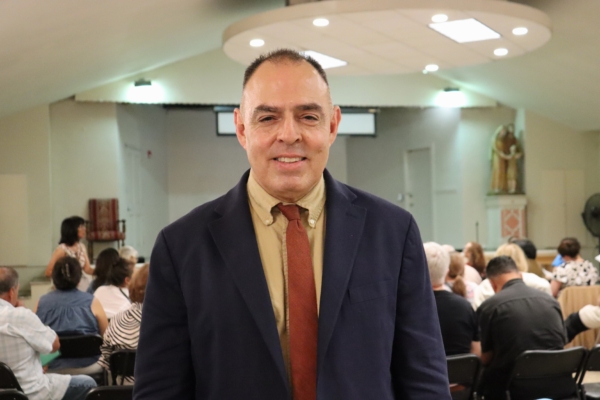On September 2nd, Dr. Pedro Antonio Casas, a retired Army colonel and practicing psychologist, conducted a session in West Covina, Los Angeles County, addressing residents’ questions about mental health and trauma healing. With 29 years of military service, Casas had worked in various countries including the United States, South Korea, Germany, Singapore, Iraq, and Afghanistan, treating many soldiers suffering from Post-Traumatic Stress Disorder (PTSD) and aiding them in their recovery. PTSD, triggered by experiencing or witnessing traumatic events such as death, severe injury, or sexual violence, manifests in symptoms like flashbacks, nightmares, severe anxiety, and uncontrollable emotional and cognitive changes.
For individuals above the age of six, direct exposure to trauma, witnessing traumatic events, or hearing about them happening to close family and friends can lead to PTSD. Even children under the age of six can be affected if they remember such events. According to Casas, law enforcement officers, military personnel, first responders, and healthcare workers are at risk of negative impacts due to repeated and profound exposure to distressing details if preventive measures are not taken.
“Intrusive symptoms,” as explained by Casas, refer to persistent thoughts that constantly flood one’s mind in dreams or during waking hours, making it difficult to shake off. Alternatively, feeling as if the traumatic event is recurring in sensations or behaviors.
Other reactions involve attempting to avoid painful memories associated with the trauma after the event, evading external cues related to the trauma like people, places, or activities. Casas emphasized that while some avoidance behavior can be healthy, others might lead to negative effects and negative emotions.
Diagnosing PTSD typically occurs after 30 days of consistent symptoms, with negative emotions encompassing memory lapses, irritability, hypervigilance, engaging in harmful behaviors, and experiencing sleep disturbances.
What is ingrained PTSD? Casas elaborated that this refers to cases where individuals did not receive any help after experiencing PTSD symptoms. For instance, when a unit is assigned a mission and faces setbacks like losing comrades or attending various mourning events upon returning, psychological impacts are inevitable.
When these individuals seek assistance, doctors might suggest rest for a few days. However, they often decline, continuing the mission repeatedly without addressing their trauma-related issues, potentially leading to physical dysfunctions that become deeply rooted and challenging to heal.
Casas recounted encounters with veterans who endured significant psychological trauma but never sought treatment. Some veterans would spend their days sitting in a chair near a window in their homes, explaining that they felt safe in that position. Encouraging them to take a walk outside might trigger panic attacks.
Casas fondly remembered Colonel David E. Cabrera, who served in the Army for over 15 years and tragically lost his life in a suicide bombing in Afghanistan after being deployed as a behavioral health officer, overseeing behavior health and combat stress programs for over 4,500 soldiers in six companies and five separate platoons.
The American Psychological Association defines evidence-based treatments as combining existing research with clinical expertise and selecting treatments that align with patients’ characteristics, culture, and preferences, including Cognitive Processing Therapy (CPT), Prolonged Exposure (PE) therapy, and Eye Movement Desensitization and Reprocessing (EMDR) therapy.
Seeking to heal both the body and mind of patients, Casas highlighted these three primary methods for effectively treating PTSD. He emphasized the importance of personalizing treatment approaches depending on the patient and their condition, following the Daubert standard to ensure evidence-based practices are upheld.
After experiencing various traumatic events such as child abuse, rape, war, or natural disasters, individuals often attempt to avoid them. CPT therapy aids individuals in shifting perspectives, learning how to assess and alter negative thoughts, thereby alleviating PTSD symptoms.
Casas noted that standard treatment often encompasses 12 sessions, although some may require ongoing therapy based on their resilience, commitment to recovery, severity of symptoms like recurrent nightmares, or reliance on alcohol for coping.
PE therapy involves repeatedly revisiting the trauma, gradually approaching the memories, sensations, and contexts related to the trauma to overcome fear. On the other hand, EMDR uses bilateral stimuli, like guided eye movements, to help patients process traumatic memories, resembling a form of hypnosis by replacing trauma with more positive memories and coping strategies.
Casas encountered many patients with traumatic brain injuries, including both closed and open head injuries. For instance, individuals exposed to sudden explosions might experience brain concussion and damage accompanied by depression and anxiety symptoms. While medication can alleviate anxiety and numb the nervous system, it carries the risk of addiction. Casas stressed the importance of caution with any substances causing dependence or hallucinations, noting the significance of appropriate dosage.
In the pursuit of self-healing, Casas advised individuals to live according to a higher purpose, envision the life they aspire to lead, focus on personal growth, ensure sufficient sleep each day, engage in activities of interest or hobbies daily, such as post-meal walks, jogging, strength training, martial arts classes, cycling on weekends, or hiking trips. Activities that replenish cortisol levels are essential for self-healing as cortisol, a steroid hormone secreted by the adrenal glands, plays a crucial role in managing stress by providing energy and regulating various bodily functions including metabolism, immune response, and blood pressure.
Listeners expressed gratitude for Casas’ insightful lecture. One woman shared her daughter’s struggle with immense psychological stress, loss of self-worth, alcohol abuse, and ultimately suicide. She lamented the lengthy wait for a doctor’s appointment, recounting days filled with prayers and feelings of helplessness.

